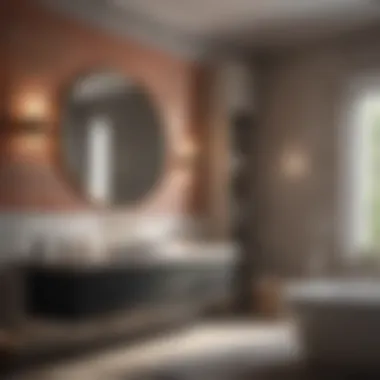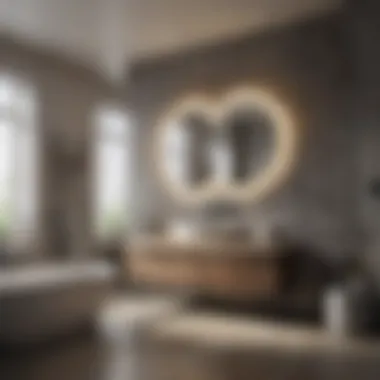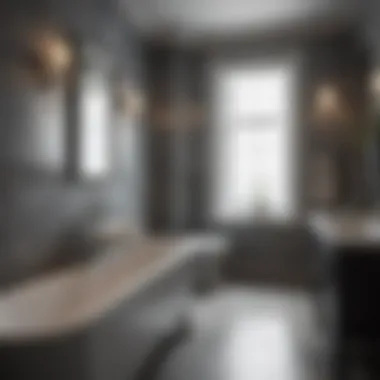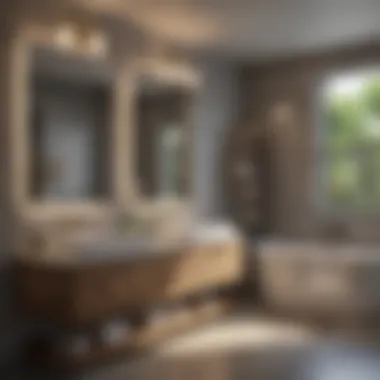Cost Analysis for Adding a Bathroom in Older Homes


Intro
Adding a bathroom to an older home is no small task. Homeowners might find themselves balancing dreams of modern comfort with the unique challenges posed by vintage structures. As properties age, their layouts can become more complex, requiring a careful touch in renovations and additions. Entering this journey without a solid grasp of the costs involved can leave one feeling as if they’re navigating a maze blindfolded. This article takes a deep dive into the financial aspects, exploring not just the expense but also the intrinsic value added to the home.
Current Trends
When it comes to bathrooms, trends shift faster than a cat on a hot tin roof. Understanding what’s in vogue can help homeowners tailor their design to ensure the addition feels cohesive with the existing home rather than a patchwork job. Popular styles range from sleek, modern designs to rustic, farmhouse charm, each with their own unique color palettes.
Color Palettes
Colors play a major role in setting the mood of a bathroom. The current favorites lean towards calming hues, such as soft blues and greens, which evoke a sense of tranquility. Moreover, warm neutrals create an inviting atmosphere while providing a timeless quality.
- Soft gray and white for a clean, crisp look.
- Earth tones to tie in natural elements.
- Pops of color like coral or teal to add personality.
Popular Styles
Styles differ based on personal taste and the architectural integrity of the home. Here’s a peek at what homeowners are gravitating towards:
- Modern Minimalism: Clean lines, open spaces, and a preference for function over form.
- Rustic Farmhouse: Natural materials, vintage fixtures, and a cozy, lived-in feel.
- Industrial Chic: Emphasizes raw materials, with metal and stone fusing together.
"Designing a bathroom is much more than just deciding on a toilet and sink; it’s about creating a space that feels like a retreat."
Visual Ideas
Visualizing the transformation can be an inspiring step forward. Homeowners might want to browse a gallery showcasing styled bathrooms to gather ideas or explore before-and-after transformations to understand what’s achievable.
Gallery of Styled Bathrooms and Bedrooms
Consider curating a Pinterest board with new images that reflect your desired style. Look for variations in layout and décor to pinpoint what resonates with you and how it can work within the old home’s structure.
Before-and-After Transformations
There’s something satisfying about witnessing a space's metamorphosis. Consider checking local renovation blogs or social media accounts that showcase dramatic transformations, often including detailed accounts of cost and labor involved.
Understanding the Basics of Bathroom Addition Costs
Adding a bathroom to an older home isn't just a matter of throwing some tiles on the floor and calling it a day. Understanding the basic costs involved is crucial for anyone thinking about such an upgrade. This section lays the groundwork for comprehending what these costs might entail and why they matter deeply in your overall renovation plans.
Homeowners often underestimate the financial commitment required for a bathroom addition. After all, it’s not merely about buying fixtures or painting walls. Costs often stem from structural considerations, which can be complex in older houses. Understanding these basics prevents unwelcome surprises down the line and paves the way for seamless decision-making.
Defining Bathroom Addition Projects
First off, let’s define what a bathroom addition project entails. It can vary widely depending on size, location, and complexity. A full bathroom typically includes a toilet, shower, sink, and sometimes a tub. In contrast, a half-bath might sport just a toilet and a sink.
When you engage in a bathroom addition project, you’re looking at:
- Scope of Work: Are you extending the footprint of your home? Or are you converting an existing space, like a closet? Each approach brings its own set of costs.
- Design Features: Simple frameless mirrors and modern sinks can eastern your budget, while elegant fixtures could break the bank.
- Existing Layout Challenges: Older homes may feature tricky layouts or plumbing limitations that complicate renovations considerably.
Each facet of your project impacts costs, so it’s essential to map out what you want clearly. It’s like cooking a gourmet meal; the recipe is only as good as the ingredients.
Assessing Structural and Design Requirements
Next, let’s tackle the importance of assessing structural and design requirements before diving into this renovation. Older homes often have their unique quirks, and ignoring these factors can lead to costly misunderstandings.
- Structural Integrity: Older homes may need more than just new tile. You might need to reinforce floors or walls, especially if you're adding significant weight from new fixtures.
- Potential Issues with Plumbing and Electrical: Older systems may not accommodate newer models or additional outlets. Upgrades here could spiral quickly, adding expenses you didn't initially foresee.
- Aesthetic Cohesion: Your new bathroom should harmonize with the home’s existing aesthetics. Decisions on finishes and materials shouldn't just look good; they must fit the overall theme of the house.
Assessing these design requirements and structural elements beforehand isn't just good practice; it's necessary for avoiding potential disasters. Homeowners often learn that skimping on proper assessments results in added costs due to repairs or replacements later on.
Remember: "An ounce of prevention is worth a pound of cure." Investing time upfront can save you a chunk of change and stress in the long run.


Factors Influencing the Overall Cost
When considering the addition of a bathroom in an older home, understanding the various elements that influence cost is crucial. This knowledge empowers homeowners to make better decisions, ensuring that their investment aligns not just with their budget, but also with their long-term goals. In this section, we break down the key aspects that contribute to the overall cost of the project.
Labor Costs: Understanding Pricing Strategies
Labor is often a significant part of any construction project, potentially accounting for 30% to 50% of the total expenses involved in adding a bathroom. Skilled tradespeople, such as plumbers, electricians, and carpenters, are essential for ensuring the project meets local building codes and safety standards.
Employers normally quote by the hour, while some may offer fixed rates for particular tasks. Thus, understanding their pricing strategies can save money down the line. Always get a few quotes—three is generally a good number—to gauge the market rate.
"The right labor team can mean the difference between a money pit and a worthwhile investment."
Material Choices and Their Impact
Material decisions heavily affect the budget. Opting for high-end finishes may enhance aesthetic appeal but can also inflate costs dramatically. For instance, selecting top-shelf vanities or luxury tiles can send expenses soaring.
Consider the following factors when choosing materials:
- Quality over Quantity: Investing in durable materials might save costs on future repairs or replacements.
- Eco-Friendly Options: Sustainable materials are becoming popular and may qualify homeowners for tax incentives.
- Local Availability: Materials sourced locally can reduce transportation costs and delays while supporting local businesses.
Permits and Compliance Costs
Lastly, permits and compliance with local building codes can add unexpected expenses to the overall cost. Requirements vary by locality, with some areas mandating permits for even minor renovations.
To avoid hefty fines or delays, consult local regulations and consider the following:
- Research Requirements: Understanding what permits are necessary beforehand can help in planning the timeline.
- Consult Local Experts: Hiring consultants who are familiar with the local landscape can streamline the permitting process.
- Cost Variations: Permit fees can range greatly, so checking in advance can prevent surprises.
Each of these factors plays a role in defining the overall expenditure of a bathroom addition. Grasping these elements will guide homeowners in crafting a well-informed, realistic budget, leading to a smoother renovation journey.
Design Considerations for an Older Home
When contemplating a bathroom addition to an older house, design considerations hold paramount importance. An older home carries a unique charm that often blends history with personality; thus, any new bathroom must respect and complement this heritage. Balancing fresh, modern utility with the existing architectural style ensures that the addition does not feel tacked on or out of place. Homeowners must reflect on how the new space harmonizes with original structures, colors, and materials. A well-thought-out design can elevate the aesthetic appeal, ensuring the property remains cohesive.
Blending Modern and Traditional Styles
The endeavor of merging modern and traditional styles can be quite a balancing act. Homeowners might ponder blurring the lines between sleek, contemporary designs and the classic elements of their older home. Considerations might include:
- Color Schemes: Opt for a palette that may reflect the older home's character while integrating modern tones to evoke freshness. For instance, using muted earth tones with splashes of contemporary grays can create a pleasant contrast.
- Materials: The choice of materials plays a crucial role. Classic features like crown moldings should find their place alongside modern fittings, such as floating vanities. A copper sink might add a vintage touch, while brushed nickel fixtures provide a sleek modern finish.
- Lighting: Incorporating both traditional chandeliers or sconces with recessed LED lighting ensures that the space feels bright yet cozy.
Ultimately, the goal is synergy; each component in the bathroom should tell a part of a larger story—one that honors the past while acknowledging the present.
Space Optimization Challenges
Crafting a bathroom in an older home often brings about unique space optimization challenges. Many older homes don't boast expansive square footage. Therefore, one must tread carefully to create a functional yet visually appealing space.
- Layout Efficiency: Maximizing comfort requires careful analysis of layout. Positioning fixtures wisely can make all the difference. For example, placing the toilet behind a wall can enhance privacy while keeping the flow streamlined.
- Storage Solutions: In older homes, storage can be sparse. Employing solutions like built-in shelves or cabinets under the sink captures otherwise wasted space. Consider add-on shelving units or alcoves that fit snugly into corners.
- Natural Light Utilization: Older homes typically have smaller windows. Finding a way to enhance natural light, perhaps with mirrors or glass doors, fosters a more open environment.
"A well-planned bathroom addition not only improves functionality, but also enriches the inherent beauty of an older home."
Effective space management, combined with thoughtful design choices, guarantees the successful integration of the new bathroom. It is essential for homeowners to outline a plan that accounts for style, layout, and function simultaneously, creating a space they can revel in for years to come.
Types of Bathroom Additions
Understanding the various types of bathroom additions is crucial when embarking on a renovation project for an older home. Each option comes with its own set of benefits and considerations that can influence both the practicality and the cost-effectiveness of the addition. Homeowners should weigh these factors carefully, as the type chosen could significantly affect daily life and even the home’s future value.
Full Bathroom Additions
Adding a full bathroom—defined as one that includes a shower or bathtub, toilet, and sink—offers the most versatility and functionality. It’s particularly advantageous for families or households expecting guests. Not only does a full bath serve practical needs, but it also enhances the overall appeal of the home.


However, with these benefits come challenges. A full bathroom requires more space and needs careful planning around plumbing and electrical setups, especially in older homes where existing infrastructure might not be adequate. Homeowners should also account for higher material costs and labor expenses relative to other types of bathrooms.
Key considerations include:
- Location: Proximity to existing plumbing will save money.
- Design Choices: Consider integrating fixtures that complement the home’s style.
- Permits: Full bathrooms frequently require more extensive permits.
This type can be a major draw for future buyers, often justifying the investment.
Half Baths and Powder Rooms
Half baths—typically containing a toilet and sink—are ideal for improving convenience without the need for extensive structural changes. Often situated near common areas like living rooms or dining rooms, they provide quick access without disrupting daily routines. Powder rooms, while similar, may be slightly larger and can accommodate extra features like storage or decorative touches.
The appeal of these spaces lies in their cost-effectiveness. Because they require less plumbing and smaller footprints, they tend to be less expensive to add. Considerations for half baths include:
- Location: Place them where foot traffic flows, enhancing usability.
- Design: Since space is limited, clever design can create a cozy feel.
- Finishes: Often, these can be stylish, serving as a room to express personal taste even in tight spaces.
Expanded storage and collected privacy, especially in homes with shared bathrooms, can sway homeowner decisions towards opting for this addition.
Ensuite Bathrooms: Benefits and Costs
Ensuite bathrooms, attached to a bedroom, are often viewed as a luxury feature that adds considerable appeal to a home. They allow for privacy and convenience, particularly for master suites. This arrangement can elevate the living experience and serves as a significant selling point in the real estate market.
However, potential additions must consider additional costs associated with plumbing, electrical work, and design integration. While the investment can be higher upfront, the return on investment often translates into increased home value. Key aspects include:
- Privacy: Adds a dedicated space that enhances personal comfort.
- Accessibility: Reduces shared bathroom congestion, a common source of frustration.
- Design Flexibility: Allows personalized features like double sinks or Jacuzzi tubs.
"Ensuite bathrooms are more than just a luxury; they reflect a lifestyle choice that balances convenience and personal elegance."
Ultimately, assessing the type of bathroom addition that makes the most sense requires understanding the unique needs of the household as well as the current home structure. The right decision can yield lasting benefits, financially and in daily life.
Hidden Costs to Consider
When diving into the depths of adding a bathroom to an older home, it’s vital to keep an eye on those hidden costs lurking beneath the surface. A new bathroom might seem like a straightforward line item on your renovation budget, but as many homeowners find out, this little project can quickly snowball into a financial avalanche if not approached with sufficient caution.
Unexpected Structural Repairs
The foundation of your renovation budget can sometimes feel like a house of cards. On the surface, everything looks good, but start peeling back layers, and you might discover cracks that demand attention. Older homes can have significant structural issues that remain concealed until the walls come down.
For instance, while you might only plan to add a new bathroom, you could unknowingly uncover rotting timber or outdated plumbing when you start the renovation. These repairs can be surprisingly hefty. Homeowners often underestimate the costs associated with fixing foundational issues. It’s essential to allocate around 10% to 15% of your overall renovation budget for these pesky surprises.
Here are a few key structural repairs to be mindful of:
- Joist Replacement: Damaged floor or ceiling joists can compromise safety and stability.
- Wall Reinforcements: Adding weight from new fixtures may require additional supports.
- Water Damage Repairs: Long-standing leaks can lead to mold and decay, demanding immediate and costly remediation.
"Understanding the potential for unexpected repairs can save you from mile-long headaches down the road."
Utility Modifications and Their Expenses
Another iceberg anyone looking to add a bathroom to an older home needs to navigate is utility modifications. In technical terms, you are not just placing porcelain on tiles; you're looking at water, electricity, and even gas lines. You may underestimate the costs of moving these utilities into a new space.
Consider the following points:
- Plumbing Costs: If the bathroom is far from existing plumbing lines, the costs can skyrocket. Depending on the distance, running new lines could be expensive.
- Electrical Upgrades: Adding new electrical outlets or lighting fixtures might necessitate an updated circuit breaker—all adding time and money to your overall project.
- HVAC Changes: Proper ventilation is crucial, which might need new ductwork or even an upgrade to your HVAC system for the added bathroom.
All told, utility modifications might take up 15% to 25% of your total renovation budget if not planned out carefully. Investing in a solid plan, ideally with a licensed contractor, can minimize these unexpected bumps on the road.
By keeping these hidden costs on your radar, you can prepare better and make informed financial decisions—a crucial boon when aiming for that modern yet harmonious bathroom in an older home.
Budgeting for a Bathroom Addition


Creating a budget for adding a bathroom to an older home is beyond mere numbers—it’s about envisioning how that new space will fit into your life and complement your home. It's easy to feel overwhelmed by the possibilities and potential costs ahead. However, having a solid grip on budgeting ensures that projects don't spiral into financial chaos. A well-thought-out budget doesn’t just keep the costs in check; it also helps prioritizing what's necessary versus what might be simply a shiny wish list.
When homeowners tackle a bathroom addition, knowing the ins and outs of budgeting acts as a compass, guiding decisions on design, materials, and labor. Failing to do this can lead to overspending or, worse, cutting corners that compromise quality.
Creating a Realistic Budget Plan
The first step in crafting a realistic budget plan is assessing the scope of the project. This includes deciding on the size of the bathroom, the type of fixtures you desire, and whether structural changes are inevitable.
- Research Costs: Spend some time familiarizing yourself with average costs in your area. Local materials may vary, so obtaining several estimates helps. Look at prices for sinks, vanities, tiles, and labor costs.
- Identify Necessities vs Luxuries: Distinguishing between absolute needs and wants is crucial. Sure, a smart shower system might catch your eye, but are you set on other more basic features first?
- Factor in Professional Services: If working with a contractor or architect, be conscious that their fees might add significantly to the budget. A great strategy is to get references and check their past work.
- Include Extras for Flexibility: Always set aside a contingency fund; typically, 10-20% of the total budget can cover unexpected expenses. Older homes can hold faux surprises beneath surfaces, such as outdated plumbing or electrical systems that don’t meet current codes.
By methodically organizing these factors, you forge a more reliable budget plan.
Financing Options Available
Once the budget is laid out, it’s essential to explore various financing strategies if out-of-pocket payments aren't feasible. There are ample routes available for homeowners, each carrying its pros and cons:
- Home Equity Loans: Tapping into your home’s equity can give you lower interest rates while you borrow a lump sum. This might suit if you plan to tackle a more substantial addition.
- Personal Loans: These unsecured loans typically come with higher interest rates than home equity loans. However, they’re often quicker to obtain, which can be necessary for those on tight timelines.
- Credit Cards: While easy to use for smaller projects, relying heavily on credit cards can burden you with high-interest rates if balances aren't paid off swiftly.
- Government Programs: Some programs are designed for home renovations, focusing on lower-income homeowners or those targeting energy efficiency. Investigate local resources to harness these funds.
- Builder Financing Plans: Some builders might offer in-house financing, which can be convenient but often comes with higher rates, so always read the fine print.
Balancing the need for funding alongside maintaining costs is a delicate act. Be realistic about your financial circumstances, weighing each option carefully. Remember: a well-planned budget combined with smart financing can make your dream bathroom a reality without breaking the bank.
"Budgeting is not about depriving oneself; it’s about empowerment and making conscious choices on how to spend your money thoughtfully."
Value Addition to the Property
Adding a bathroom to an older home is not just about aesthetics or convenience; it can significantly impact the property's value. Homeowners often overlook this vital aspect, focusing solely on immediate costs and planning challenges. However, understanding the potential return on investment (ROI) and how it aligns with market trends can provide a compelling case for such renovations.
Return on Investment Considerations
When thinking about adding a bathroom, it's crucial to consider how this investment will pay off down the line. Experts indicate that on average, adding a bathroom can recoup about 50-70% of its costs when you sell your home. This figure can vary greatly depending on local market conditions.
- Market Comparisons: It's advisable to check recent sales in your neighborhood. If homes with additional bathrooms are fetching higher prices, this is a strong indicator that adding one could enhance your property value.
- Buyer Expectations: Today's homebuyers often expect multiple bathrooms, especially in family homes. Fulfilling this requirement can make your property more appealing. A second or third bathroom might be the difference between a home sitting on the market or closing quickly.
- Quality of Materials and Design: While a high-end remodel can yield impressive returns, not every market will respond the same way. Sometimes, a more budget-conscious approach can still yield a favorable ROI. Invest wisely in materials and design that align with the overall character of your home.
Market Trends in Home Renovation
Keeping an eye on market trends can provide insight into the best time to add a bathroom. The construction and real estate markets fluctuate, and understanding these trends is essential for homeowners. Here are a few current trends:
- Rising Home Values: Many regions are experiencing a rise in home values, making it an excellent time to invest in renovations that can offer decent returns.
- Focus on Functionality over Luxury: While luxury bathroom fixtures are popular, the current trend favors practicality. Features like functional designs and eco-friendly fixtures can impress buyers without breaking the bank.
- Increased Interest in Multi-Generational Homes: As families grow more complex, there’s a heightened need for additional bathroom space to manage larger households, thus increasing the demand for bathroom additions.
A well-planned bathroom addition not only enhances your home’s aesthetic but can also serve as a smart financial move in today’s ever-evolving housing market.
In summary, the value addition from a bathroom remodel is more than just numbers on paper. It’s about understanding your market and making informed decisions that serve your lifestyle and investment goals.
Final Thoughts on Adding a Bathroom
Adding a bathroom to an older home is more than just a construction project; it's an investment with a ripple effect on comfort, usability, and property value. This segment ties together all we've examined so far, offering a holistic viewpoint on the significance of making this decision carefully.
When to Proceed with the Project
Timing plays an essential role in the success of a bathroom addition. It’s critical to consider several factors before taking the plunge. Firstly, assess the state of your home: is it structurally sound? Address any lingering issues, such as plumbing or foundational concerns, before investing in an addition.
Additionally, consider the current market trends in your area. Are home values appreciating? If the housing market is hot, you might see a quicker return on investment. You should also think about your family’s growing needs. With kids reaching their teens, or if you’re taking in elders, an extra bathroom can be a game changer for daily routines.
When unsure, sometimes the best strategy is to play the waiting game, allowing your budget to mature and the project to crystallize.
The Importance of Professional Guidance
Navigating a bathroom addition can feel like wandering through a maze of options. Having a professional on your side can save you more than just headaches. A skilled architect or contractor knows how to draw from your vision while still adhering to local codes and regulations. They might also catch details you might miss—like the location of existing plumbing or the potential for lighting improvements.
*
- Expertise: They can provide insights based on experience, which can help avoid costly mistakes.
- Time management: A professional keeps the project on track, which is crucial for minimizing disruptions to your daily life.
- Quality assurance: Pros have the resources to source durable materials that will withstand the test of time.
"A well-planned bathroom addition doesn’t just enhance your living space—it significantly boosts your home’s market appeal."
In summary, adding a bathroom holds pieces of promise for comfort and home equity, but the timing and expertise invested in the process are what will ultimately lay the groundwork for its success.



